
Updated: Feb. 18, 2024
Tokyo National Museum (東京国立博物館) in Ueno Park, Tokyo is one of Japan’s most prominent museums. Clustered in six museum buildings, one is the swank-looking Gallery of Hōryūji Treasures (Hōryūji Hōmotsukan 法隆寺宝物館) exhibiting precious Buddhist art and artifacts from Hōryūji, one of Japan’s oldest and most famous Buddhist temples in Nara Prefecture.
On January 31, 2023, the Gallery of Hōryūji Treasures opened a new exhibition space named “Digital Gallery of Hōryūji Treasures” (デジタル法隆寺宝物館) to show high-resolution images and reproductions of masterpiece paintings and murals from Hōryūji Temple.
The Digital Gallery is holding the following two exhibitions alternately for six months at a time starting in Jan. 2023:
・First exhibition in 2023: Illustrated Biography of Prince Shōtoku (January 31, 2023–July 30, 2023)
High-resolution digital images and full-scale reproduction of 11th-century, Yamato-e paintings (National Treasure) depicting Shotoku Taishi’s major events and superhuman feats in his illustrious life.
・Second exhibition in 2023: The Murals of Hōryūji Temple (August 1, 2023–January 28, 2024)
High-resolution digital images and reproduction of 7th–8th century Buddhist murals originally in Hōryūji’s Kondo main worship hall (金堂) before they got damaged by a fire in 1949.
・First exhibition in 2024: Illustrated Biography of Prince Shōtoku (January 30, 2024–July 28, 2024)
High-resolution digital images and full-scale reproduction of 11th-century, Yamato-e paintings (National Treasure) depicting Shotoku Taishi’s major events and superhuman feats in his illustrious life.
・Second exhibition in 2024: The Murals of Hōryūji Temple (July 30, 2024–January 26, 2025)
High-resolution digital images and reproduction of 7th–8th century Buddhist murals originally in Hōryūji’s Kondo main worship hall (金堂) before they got damaged by a fire in 1949.
etc.
Page Contents
- Exhibition at Digital Gallery of Hōryūji Treasures
- Exhibition hours & location
- About Shotoku Taishi
- About Yamato-e paintings
- Other exhibitions at Gallery of Hōryūji Treasures
- Gigaku and gigaku masks
- About Tokyo National Museum
- About Hōryūji Temple
Why is there a Hōryūji museum in Tokyo instead of in Nara?
So happens that Hōryūji Temple donated 319 precious cultural artifacts to the Imperial Household (Japanese emperor’s family) in 1878. Hōryūji had Imperial ties via its founder Shotoku Taishi, an Imperial prince (emperor’s son) in the 7th century. After World War II, this Hōryūji collection was transferred to Tokyo National Museum to become state property of Japan.
What about the Shosoin Repository (正倉院) in Nara? What’s the difference?
Long associated with Todaiji Temple in the city of Nara, Shosoin Repository, now under the management of the Imperial Household Agency since 1884, holds another major collection of ancient art in Nara.
The difference is that Shosoin’s collection centers on the 8th century, while the Gallery of Hōryūji Treasures centers on 7th-century relics.
Note that the Shosoin Repository is not a museum. It does not exhibit its collection except at Nara National Museum in autumn or at other museums on loan. You can search for and see photos of their holdings on their website.
What’s new at the Gallery of Hōryūji Treasures?

The mezzanine floor in Gallery of Hōryūji Treasures has been remodeled into the Digital Gallery of Hōryūji Treasures (デジタル法隆寺宝物館). It is outfitted with two 70-inch monitor screens to show high-resolution, 8K images of paintings and murals from Hōryūji Temple in Nara. This digital system affords unprecedented closeups of every detail.
Visitors can use the interactive tablet screens in English or Japanese to browse through the digital images on the large monitor screen and read English annotations about the painting’s points of interest.
There are also full-size reproductions on the walls.

Instead of digital images, why not exhibit the original paintings?

The original paintings have been exhibited in the past for short periods like about a month, but they are too fragile to be exhibited on a permanent or long-term basis.
To compensate for this and have more people enjoy and understand the paintings for a longer period, this digital gallery was created to enable long-term exhibitions. Full-size or scaled-down reproductions mounted on the walls also complement the large monitor screens.
What’s showing at the Digital Gallery of Hōryūji Treasures?
The Digital Gallery of Hōryūji Treasures will hold six-month exhibitions alternating between the following two masterpieces from Hōryūji Temple.

・First exhibition: Illustrated Biography of Prince Shōtoku (first half of the year: January to July)
The first exhibition shows an epic series of Yamato-e paintings named Illustrated Biography of Prince Shōtoku (Shōtoku Taishi E-den 聖徳太子絵伝).
Prince Shōtoku or Shōtoku Taishi (574–622) was an Imperial prince (second son of Emperor Yōmei) who was pivotal in introducing Buddhism to Japan and spreading the religion. He is one of Japan’s most famous historical figures and the founder of Hōryūji Temple in Ikaruga, Nara.
The paintings on ten silk panels chronicle 57 superhuman events or deeds in Shōtoku Taishi‘s life (574–622). Some events, like him going eastward and flying over Mt. Fuji on a horse or levitating in the air at age 11, are extraordinary as Shotoku Taishi had become a semi-divine or semi-Buddha cult figure.
The original paintings are a National Treasure dating from 1069 (Heian Period), about 400 years after Shōtoku Taishi’s death. The painter was Hata no Chitei (秦致貞) whom little is known.
The paintings originally adorned Hōryūji Temple’s E-den (絵殿) or Hall of Paintings.
There are also other art works titled Illustrated Biography of Prince Shōtoku created later such as a picture scroll version. However, the Yamato-e version is the oldest in existence.
![The last two panels (9 [right half] and 10 [left half]) shows Shitennoji Temple (四天王寺) in Naniwa, Osaka built in 593 by Prince Shotoku even before Horyuji](https://photoguide.jp/log/wp-content/uploads/2023/02/20230130_9204ChinaMtHeng-Shitennoji-NaniwaS.jpg)
The locations depicted in the paintings include Prince Shotoku’s Ikaruga Palace and the 7th-century Japanese capital of Asuka in Nara. There’s also Naniwa in Osaka (Shitennoji Temple) and Mt. Heng, one of the most sacred mountains in China.
Although the Illustrated Biography of Prince Shōtoku is a splendid example of early Yamato-e Japanese paintings and a great narrative of Shotoku Taishi’s superhuman feats, the painting itself is in poor condition with faded paint and many faces and figures peeled away or rubbed out.
Although the 8K digital images can give extreme closeups of the painting, we mostly see how much detail is missing. It’s up to our imagination to fill in the blank spots.
The good news is that a replica of the painting was produced in the 18th century (Edo Period). The replica is in Hōryūji Temple’s E-den (絵殿) or Hall of Paintings. The replica looks to have more detail, so be sure to see it when you visit Horyuji.

This is not the first time this 8K digital exhibition of the Illustrated Biography of Prince Shōtoku was held. It was actually held before for a month in autumn 2018 in the Gallery of Hōryūji Treasures mezzanine. However, it will now become part of the museum’s regular exhibition.
Also, in September–October 2020, there was the Illustrated Biography of Prince Shōtoku exhibition with AR (augmented reality) imagery showing restored images of Prince Shotoku in the painting. This website shows a few restored images of him in the painting (levitating, flying over Mt. Fuji, etc.): https://adp.au.com/eden/
This website shows high-resolution images of all the panels of Illustrated Biography of Prince Shōtoku: https://emuseum.nich.go.jp/detail?content_base_id=100205&content_part_id=001&content_pict_id=001&langId=en
Short official video about the painting (English subtitles provided): https://youtu.be/sJB-03HQMNA
・Second exhibition: The Murals of Hōryūji Temple (second half of the year: August to January)

Image courtesy of Tokyo National Museum.
The Digital Gallery’s second exhibition shows high-resolution images and scaled-down reproductions of twelve murals which once covered the inner walls of the Kondo (金堂), Hōryūji’s main worship hall.
The Kondo is the Hōryūji’s most important building and National Treasure. It houses thirteen Buddha statues. It’s one of the world’s oldest wooden buildings along with the adjacent Five-Story Pagoda, also a National Treasure. Open to the public.
The twelve murals date from the latter 7th and early 8th centuries and show large Buddhas, smaller Bodhisattvas, Kannon, and the Buddhist Pure Land. The painter(s) is unknown. The original murals were highly acclaimed, even overseas. (Read more here.)
However, unfortunately, on January 26, 1949, while the Kondo was being disassembled and renovated, a fire broke out and damaged much of the precious murals and pillars on the inner sanctum’s first floor.
The fire shocked and saddened the nation as well as many people overseas, like when the Notre-Dame cathedral caught fire in Paris, France in 2019.
The fire spurred the Japanese government to enact the Law for the Protection of Cultural Properties (文化財保護法) in 1950 and also designate January 26 as “Cultural Property Fire Prevention Day” (文化財防火デー) from 1955. On this day, Japanese fire departments may conduct fire drills by spraying water on Important Cultural Property and National Treasure buildings.
Fortunately, the Kondo Buddhist murals had been photographed in detail in 1935 by a fine-art printing company in Kyoto named Benrido (便利堂) as part of a project to accurately document Hōryūji’s cultural properties. The project was directed by the Japanese Ministry of Education.
In 1967–1968, these photographs were used as underlay images to replicate the murals in the actual size. Top Japanese painters helped to paint and color the murals on washi paper. The replicated Buddhist murals can be viewed in Kondo Hall.
To photograph the murals, Benrido had a team of eleven people use a custom-made, extra large-format camera using glass photographic plates (dry-plate collotype) made by Ilford Photo measuring as large as a whopping 24 in. x 18 in. (61 cm x 46 cm) or around A2 paper size. The glass plates were coated with photosensitive material.
Each mural was photographed in a rectangular, grid pattern at 1:1 magnification. The largest murals required 42 photos and the smaller murals needed 24 photos to be entirely captured on the glass plates. The images were later stitched together.
The camera was mounted on a frame parallel to the vertical mural and could slide vertically and horizontally over the mural to take the photos. For the lighting, a 250-watt incandescent bulb was mounted to each of the four corners of the camera. (This video shows how they did it.)
A total of 374 images on glass photographic plates (a few were partially redundant) were taken, and 363 of them were cleaned, restored, and digitized with large-scale scanners, taking five years from 2016.
Glass plates are much more durable than film and do not stretch nor distort the image. They preserved the captured images very well and retained excellent image detail. See one example here.
In 2015, the photographic plates were designated as National Important Cultural Properties. Both Ilford Photo in the UK and Benrido (founded in 1887) in Kyoto are still in business today.
High-resolution, 8K black-and-white images digitized from these photographic plates will be shown on the large monitor screens in the Digital Gallery.
It will be a striking contrast of state-of-the-art, imaging technologies, almost 90 years apart. Images on A2-size glass photographic plates verses 8K digital imagery with billions of pixels. Standing the test of time.
Images of the murals are also viewable online in color here: https://view.horyuji-kondohekiga.jp/

Is the exhibition in English?
Yes. One of the two touch-panel tablets has an English interface for selecting a painting panel and reading annotated points of interest in English on the large monitor screen.
The other tablet is in Japanese displaying the Japanese version on the monitor screen.
The official website also has an English version (National Center for the Promotion of Cultural Properties).




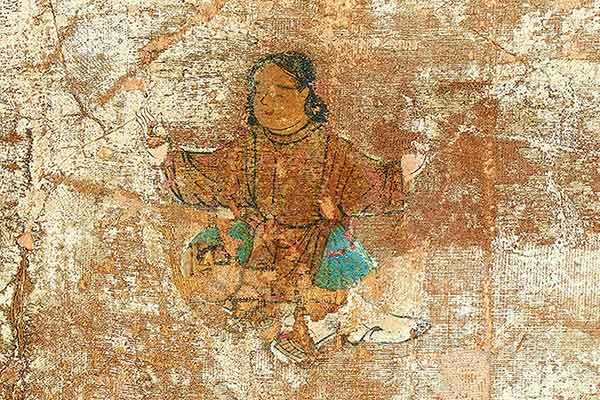
When, where, how much, and how to get to the museum?
Digital Gallery of Hōryūji Treasures Exhibitions
When:
・Illustrated Biography of Prince Shōtoku – Late January to late July
・The Murals of Hōryūji Temple – Early August to late January (following year)
*The exhibition in the Digital Gallery of Hōryūji Treasures alternates between the Illustrated Biography of Prince Shōtoku and The Murals of Hōryūji Temple every six months. For exact dates, see the official website.
Museum hours: 9:30 a.m.–5:00 p.m. (enter by 4:30 p.m.)
Closed: Mondays (open if a national holiday and closed the next day instead), year-end period, and Jan. 1
Where: Gallery of Hōryūji Treasures, Tokyo National Museum, Ueno Park (see map and directions below)
Admission: ¥1,000 for adults, ¥500 for college students, free for visitors below age 18 or over 70 and disabled visitors. (Admission is valid for all Tokyo National Museum museums/galleries except for special exhibitions. To check current admission prices, see the official website.)
Accessibility: The Gallery is wheelchair accessible with slopes, elevator, and accessible toilet. Details here.
Directions: Within Ueno Park near Ueno Station (JR, Keisei, Hibiya, and Ginza Lines).
Address: Ueno Koen 13-9, Taito-ku, Tokyo, Japan
Map here
More info: https://cpcp.nich.go.jp/modules/r_exhibition/index.php?controller=dtl&id=34&lang=en
Is there a restored version of the Illustrated Biography of Prince Shōtoku paintings?
The closest thing is the replica paintings in Hōryūji Temple’s E-den (絵殿) (Hall of Paintings). They were produced in the 18th century and should show better detail. The hall is next to the Yumedono Pavilion.
Also see this website for a few restored images of Prince Shotoku in the paintings: https://adp.au.com/eden/
Where are the original paintings and murals today?
The original Illustrated Biography of Prince Shōtoku Yamato-e paintings are kept at Tokyo National Museum.
The Kondo main hall’s original and fire-damaged Buddhist murals are kept in a storehouse at Hōryūji, not open to the public. A replica produced in 1967–1968 by famous painters is exhibited inside the Kondo.
Who was Shōtoku Taishi (聖徳太子)?

Shōtoku Taishi or Prince Shōtoku (574–622) is one of Japan’s most famous historical figures bordering on legend. He is largely credited for introducing Buddhism to Japan from China and spreading Buddhism in Japan despite his background in the native Shinto religion. (The Imperial family was believed to be descended from Shinto gods.)
He also wrote the Seventeen-Article Constitution in 604, Japan’s first so-called “Constitution,” calling for peace and harmony and outlining proper behavior by government officials and the emperor’s servants based on Buddhist and Confucian thought.
He founded Hōryūji Temple in Nara in 607 to fulfill the wish of his father Emperor Yōmei who wanted to build a temple to cure his illness. However, the father had died around 587 before the temple was completed.
Today, Hōryūji is one of Japan’s most famous Buddhist temples noted for the world’s oldest wooden buildings. Prince Shōtoku is also an object of worship at the temple.
Shōtoku Taishi himself attracted a large cult following and inspired the founders of major Japanese Buddhist sects. He is still universally revered at many Buddhist temples in Japan which keep images or statues of him to worship.
Until 1984, he was most famous for his iconic image on the old ¥10,000 Japanese bill. He was even on the ¥1000 and ¥5000 bills at one time or another in the 1950s.
What are Yamato-e paintings (大和絵)?

Yamato-e paintings are classic, Japanese-style paintings depicting a narrative. Typical characteristics include small human figures, buildings (with cutaways showing the interior), landscapes, and golden clouds obstructing the full view of the scene.
Being a National Treasure, the Illustrated Biography of Prince Shōtoku is a major example of Yamato-e. Another example is the Tale of Genji Picture Scroll (Genji Monogatari Emaki 源氏物語絵巻) from around the 12th century (Heian Period).
What else is exhibited at Gallery of Hōryūji Treasures?


A lot. In 1878, Hōryūji Temple donated over 300 historic art pieces and objects to the Imperial Household. After World War II, the collection went to Tokyo National Museum.
To preserve and exhibit this collection, the Gallery of Hōryūji Treasures (Hōryūji Hōmotsukan 法隆寺宝物館) was built in 1964 as part of Tokyo National Museum (Tōkyō Kokuritsu Hakubutsukan 東京国立博物館).
In 1999, a new building designed by acclaimed architect Taniguchi Yoshio was built for the Gallery of Hōryūji Treasures. It has two floors and a mezzanine.
The first floor has three darkened exhibition rooms. They currently exhibit kanjo-ban banners (for the Kanjo Ceremony), a large collection of gilt bronze Buddhist statues and their detached metallic halos, repoussé Buddhist reliefs, and gigaku masks.
The mezzanine has the Digital Gallery of Hōryūji Treasures including one of the reconstructed gigaku masks and a gigaku costume in a showcase.
The second floor has three exhibition rooms. They show Buddhist wooden objects (incense wood, musical instruments, etc.), lacquerware, metallic objects (incense burner, bronze mirrors, etc.), paintings, calligraphy, and fabrics.



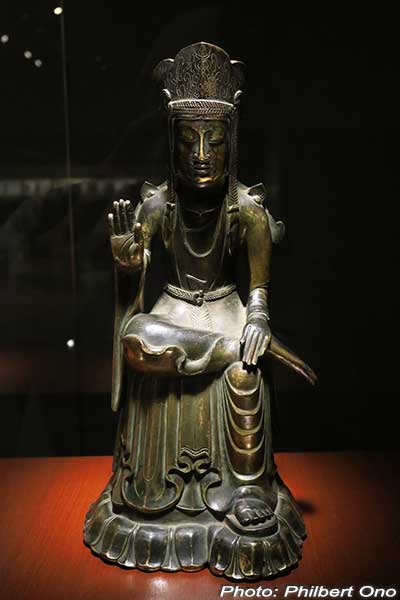

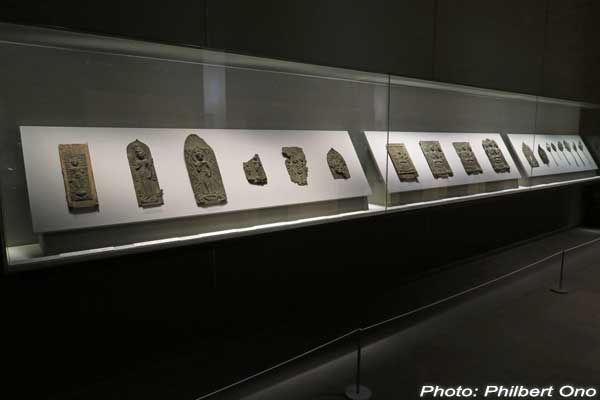
Right: Repoussé Buddhist reliefs. Gallery of Hōryūji Treasures 1st floor.
What is gigaku? (伎楽)

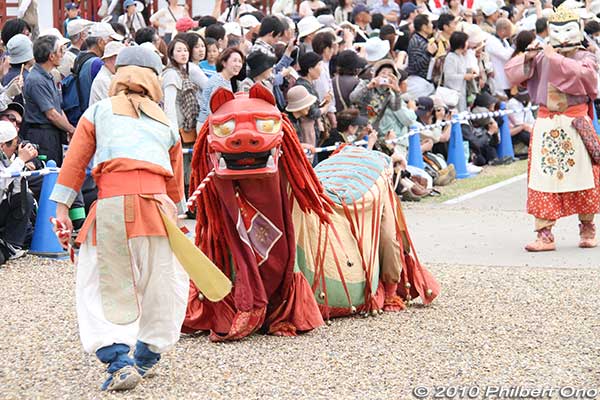
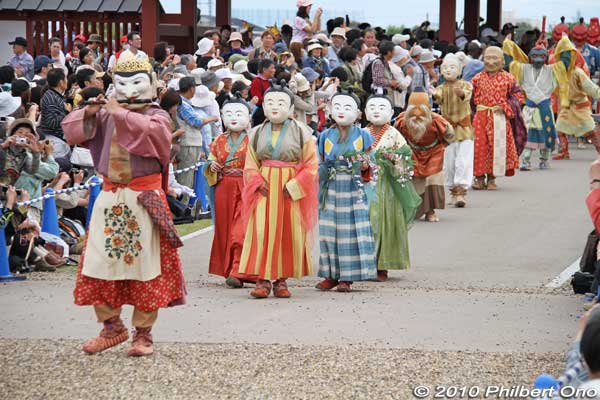
Gigaku was an outdoor Buddhist ceremony consisting of a procession of masked performers who gave mime performances accompanied by music. Under the auspices of Prince Shotoku, it was brought to Japan from China/Korea in the 7th century.
The mime performers wore fantastical, wooden gigaku masks (伎楽面). Their mime performances were farcical (and sometimes obscene) while integrating Buddhist beliefs. They performed at Buddhist services or served as entertainment for important guests.
Gigaku was introduced to Japan around the time Prince Shotoku founded Horyuji in 607. It was performed often at Horyuji and at Todaiji Temple’s dedication ceremony for its Great Buddha in the 8th century.
There are theories about gigaku inspiring today’s shishi-mai lion dance and the long-nosed, tengu goblin character (Sarutahiko).
However, gigaku eventually lost popularity and died out after the 8th century. Very little documentation about gigaku remains.
Nevertheless, it has been regarded as an important legacy and remnant of Shotoku Taishi, and Horyuji Temple preserved the surviving masks for over a thousand years until they were donated to the Imperial Household in 1878.
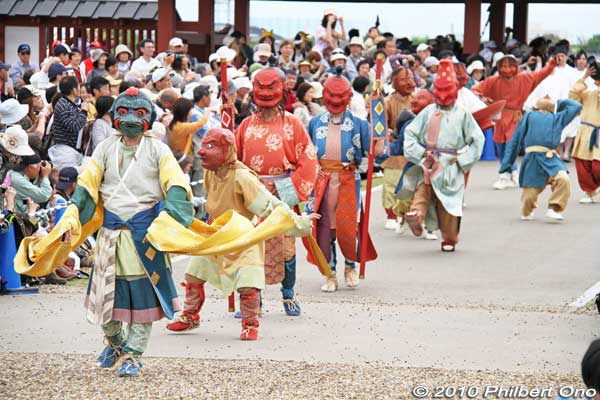
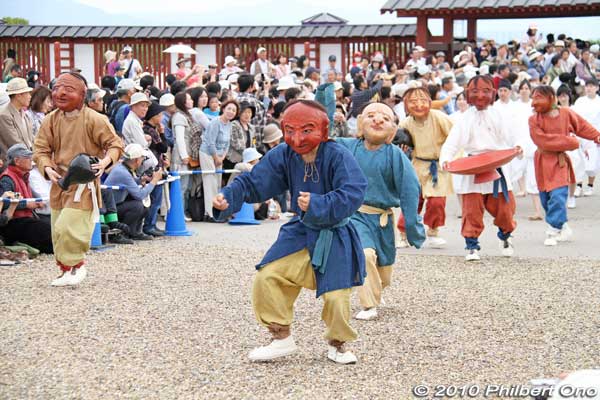
It wasn’t until 1980 when gigaku started to be revived by Tenri University‘s gagaku court music club in Nara. They hold public performances of gigaku. (More info below.) Other performers have also emerged, calling it “Shin-gigaku” or a modern version of gigaku.
What kind of Gigaku masks are exhibited? (伎楽面)

The Gallery of Hōryūji Treasures has a dedicated room exhibiting 31 precious gigaku masks. Nineteen of them date from the 7th century and are made of camphor wood. Others are made of paulownia wood. They are among the oldest masks in the world.

In 2019, two of the gigaku masks were colorfully reconstructed into what they might have looked like originally. One is a Chinese maiden mask named Gojo (呉女), photo above. It might be an expression of ideal Chinese feminine beauty with half-closed, slitty eyes; small lips; and puffy cheeks.

Right photo: Courtesy of Tokyo National Museum.
Another reconstructed mask is the sacred bird mask called Karura or Garuda (迦楼羅), a mythological creature with a bird’s head and human torso, originating from India. The character must’ve been a gigaku crowd pleaser as it flapped its wings (arms).
The original mask is missing the comb on the head, but it was found in a museum in Germany (!) and used as a model to reconstruct it. Colors are based on pigment fragments on the original mask. This reconstructed bird mask will be exhibited in the museum from August 2023.
Gigaku costumes were also remade based on surviving pieces of fabric and they are also exhibited.
This official video shows how the two masks were reconstructed.

Right: Chido (治道) or Path Sweeper who leads the gigaku procession while clearing/purifying the path.
The gigaku mask collection is very diverse. Mostly male, one female, and imaginary creatures. They give you an idea of what ancient Japanese cosplayers looked like. Nice to see some of them smiling or looking happy even in the 7th century. Humans have always been human.
This website shows nice photos and English captions of all 31 gigaku masks at the museum: https://emuseum.nich.go.jp/detail?content_base_id=100769&content_part_id=001&content_pict_id=003&langId=en
*Special thanks to Alice Gordenker for the tour of Gallery of Hōryūji Treasures in late January 2023.
Are there any other authentic gigaku masks?
Yes, both the Shōsōin Imperial Repository and Tōdaiji Temple in Nara have a collection of gigaku masks (not normally on public display), but most date from the 8th century while Gallery of Hōryūji Treasures has mostly 7th-century gigaku masks. Shōsōin’s gigaku masks indeed look quite different from Hōryūji’s 7th-century masks. You can search for and see photos of Shōsōin’s gigaku masks here (official website).
Note that the Shosoin Repository is not a museum. It does not exhibit its collection except at Nara National Museum in autumn or at other museums on loan.
Can I see masked gigaku performers somewhere?


Yes, it’s possible. At Tenri University in Tenri, Nara Prefecture, the gagaku court music club (天理大学雅楽部) actively perform gigaku in Nara.
Besides periodic gagaku concerts which include gigaku, they perform gigaku every year at Todaiji Temple (東大寺) and Yakujishi Temple (薬師寺) on May 5 (Genjo-sanzo-e Taisai 玄奘三蔵会大祭) in Nara.
In Tokyo, they will hold a gagaku/gigaku concert on March 5, 2023 at Asakusa Public Hall.
Their gigaku costumes are reproduced as much possible based on original, surviving gigaku costume pieces in Shosoin Repository. It was a major project to try and reproduce the original dyes, colors, weaving methods, etc.
Tenri University’s gagaku music club started reviving and performing gigaku when they were asked by NHK TV to perform it at the 1980 dedication ceremony for Todaiji Temple’s completion of major renovations that took six years (昭和大修理). Founded in 1951, Tenri University’s gagaku club was well developed with a good number of members holding performances on a regular basis.
Under the guidance of Japanese music scholars, the club has been practicing and performing gigaku ever since and has gradually resurrected and developed their own gigaku repertoire to suit the temples where they perform. Their gigaku mime performances depict some aspect or story related to the temple where they perform.
Their most memorable performances include the one held in 2002 at Todaiji Temple for the 1250th anniversary of the temple’s dedication of its giant Buddha statue. Video: https://youtu.be/V52ibN8ZzEw?t=63
And in 2010, when a six-month celebration was held to mark the 1300th anniversary of Japan’s capital moving from Fujiwara-kyo (Kashihara, Nara) to Heijo-kyo Capital in Nara city in 710 (平城遷都1300年祭), Tenri University’s gagaku club members appeared in gigaku masks in the Tempyo Gyoretsu procession (photos above) with 1,300 people in Tempyo (Tenpyo) Period (729-749) costumes marching to the reconstructed Heijo-kyo Palace in Nara city.
More recently in September 2017, Tenri University’s gagaku club members teamed up with Nara University‘s gagaku study group (奈良大学 雅楽研究会) to hold a joint gigaku performance at the opening ceremony of the 17th National Cultural Festival in Nara (第32回国民文化祭・なら2017、第17回全国障害者芸術・文化祭なら大会). The opening ceremony was held at Todaiji Temple officiated by then Crown Prince Hiro and Crown Princess Masako.
About Tokyo National Museum

Anchoring the far end of Ueno Park, Tokyo National Museum is a complex of six museum buildings. Front and center is the distinctive, Japanese-style main museum named Honkan (本館), aka Japanese Gallery built in 1938.
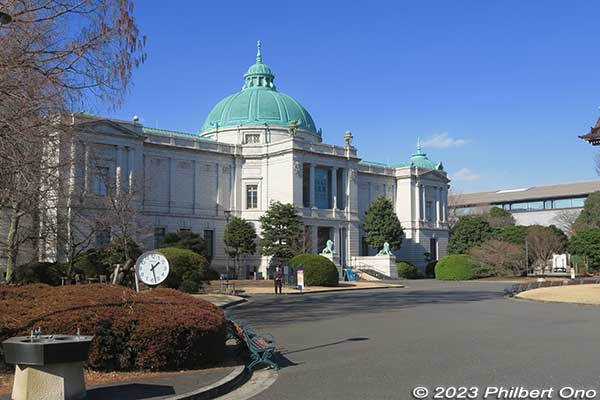

The main building is flanked by the Western-style Hyokeikan (表慶館) on the left, the Toyokan (東洋館) on the right, and the modern Heiseikan (平成館) behind on the left for archaeology and special exhibitions.

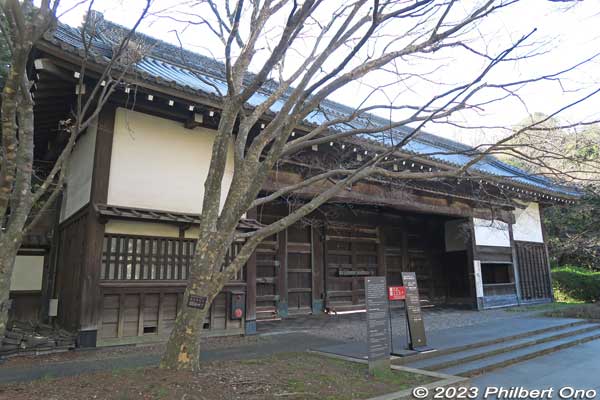
After entering the main gate, the Gallery of Hōryūji Treasures (Hōryūji Hōmotsukan 法隆寺宝物館) is further toward the left (follow the signs). You will pass by Kuromon Gate (黒門).
Slightly outside the main complex is Kuroda Memorial Hall where the admission is free.
Each museum building has a different exhibition theme, and you can spend hours in each one. After paying admission at the Main Gate, you can enter all of the museums.
English map of the museum complex here.
Japan’s national art museums are managed by the National Center for the Promotion of Cultural Properties.
Tokyo National Museum
Open: 9:30 a.m.–5:00 p.m. (enter by 4:30 p.m.), closed Mondays
Regular admission: ¥1,000 for adults, ¥500 for college students, free for kids below age 18, elderly over age 70, and disabled persons. (Special exhibitions require a separate admission fee.)
Buy tickets at the ticket booth near the Main Gate.
Accessibility: All the museums are wheelchair accessible. Details here.
Getting there
Near Ueno Station on the JR, Keisei, Hibiya, and Ginza Lines. Also near Uguisudani Station.
Address: Ueno Koen 13-9, Taito-ku, Tokyo, Japan
In Ueno, museums and more museums…

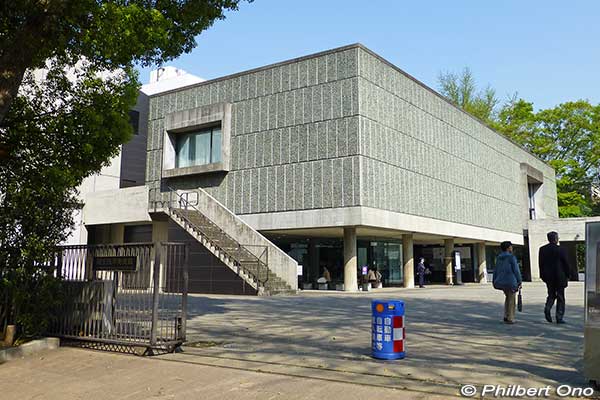
Besides Tokyo National Museum, Ueno Park is also home to National Museum of Nature and Science, National Museum of Western Art, Tokyo Metropolitan Art Museum, The University Art Museum, Tokyo University of the Arts, and Ueno Royal Museum. There’s also the Shitamachi Museum at Shinobazu Pond, but it’s closed until spring 2025 for renovations.
These museums are lucky to make use of this huge, centrally-located park formerly occupied mostly by Tendai Buddhist temple Kan’eiji (寛永寺) whose main worship hall (Konpon Chudo) was on the site of Tokyo National Museum’s Honkan main building. Kan’eiji was almost completely destroyed by a battle in in July 1868 when the Tokugawa samurai government was being overthrown by Emperor-backed forces.
Kan’eiji was later rebuilt on a smaller scale and in a slightly different location. Its temple buildings are scattered about in Ueno Park, with the main worship hall now outside the northwest corner of the Tokyo National Museum complex. Worth a visit.
Visiting Ueno Park is a good way to overdose on museums if you don’t get distracted by Ueno Zoo or Shinobazu Pond nearby. Or by the famous cherry blossoms in late March. Enjoy Tokyo’s museum mecca.

Horyuji Temple in Nara
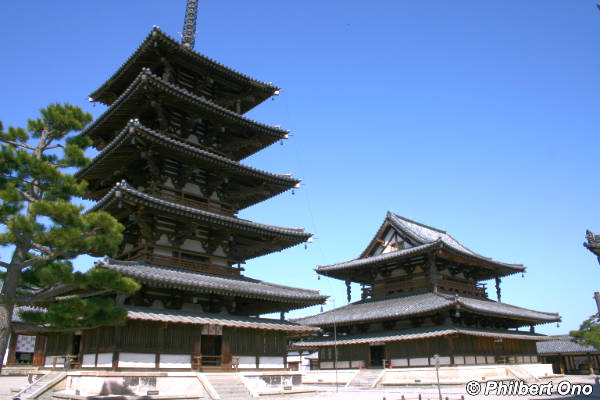

The famous Horyuji Temple (法隆寺) is a major tourist attraction and place of worship in Ikaruga, Nara Prefecture. Founded in 607 by Imperial prince and Buddhist evangelist Shotoku Taishi (聖徳太子), Horyuji is the headquarters of the Shotoku-shu Buddhist sect (聖徳宗). It worships Shakyamuni Buddha (Shaka Nyorai) and also serves as a seminary and monastery.
Also called Ikaruga-dera (斑鳩寺), Horyuji is one of Japan’s most renown temples, with the world’s oldest wooden buildings (over 1,300 years old) and honored as Japan’s first UNESCO World Heritage Site. Part of it is on the former site of Prince Shotoku’s Ikaruga Palace.
Two of the temple complexes are open to the public, the Sai-in Garan west complex/precinct (西院伽藍) and the smaller To-in Garan east complex/precinct (東院伽藍). Both complexes are next to each other and you can easily walk between both.
Most people first enter the west complex which has Kondō Hall (金堂), Five-story Pagoda (Gojū-no-Tō 五重塔), Chūmon Gate (中門), and Covered Corridor (Kairō 廻廊) or cloister. They are all National Treasures and among the oldest wooden buildings in the world.
Kondō Hall has noticeable Chinese design elements. Hard to believe it once suffered a major fire. Enter to see 13 Buddha statues and replicas of the Buddhist murals, but no photography is allowed inside.
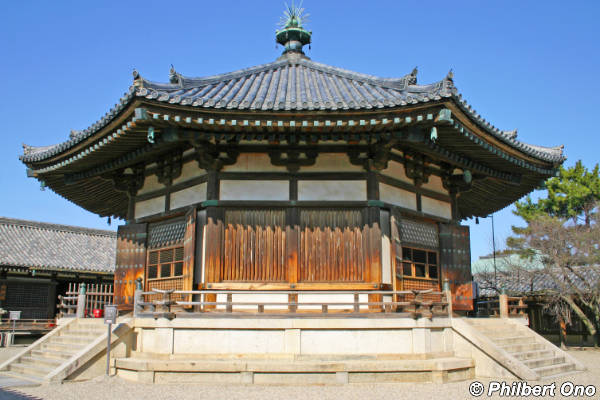
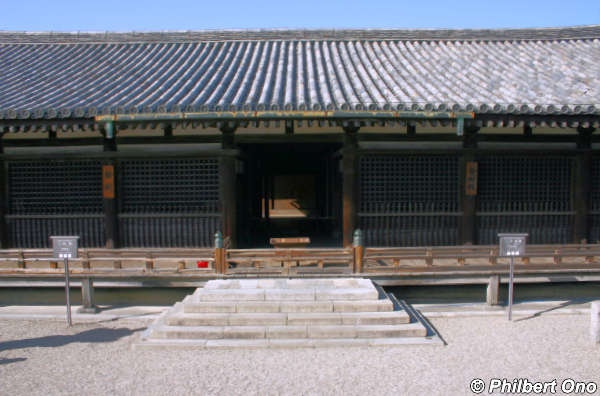
A short walk away is the To-in Garan east complex (東院伽藍), the former site of Prince Shotoku’s palace. The most beautiful building there is Yumedono Pavilion (夢殿), or Hall of Dreams, a National Treasure and memorial hall for Prince Shotoku. It was built 100 years after his death. The Nippon Budokan martial arts hall in Tokyo was designed after this jewel-topped, octagonal building. The similarity is striking.
Next to Yumedono Pavilion is the E-den (絵殿) or Hall of Paintings where a reproduction of the Illustrated Biography of Prince Shōtoku (Shōtoku Taishi E-den 聖徳太子絵伝) is displayed. This 18th-century replica should be in better condition than the original paintings at Tokyo National Museum.
If you visit Nara, Todaiji Temple is another great temple not to be missed. Note that the Shosoin Repository is not a museum. You can visit the building, but nothing is exhibited. They exhibit selected items at the Nara National Museum every autumn.
Horyuji Temple
Open: 8:00 a.m.–5:00 p.m. (closes at 4:30 p.m. during Nov. 4–Feb. 21)
Admission: ¥1,500 for adults (age 12 and older), ¥750 for children
Getting to Horyuji Temple
Near JR Horyuji Station on the JR Yamatoji Line, about 13 min. from JR Nara Station. From JR Horyuji Station, 5-min. bus ride or 15-min. walk.
Address: 1-1 Horyuji Sannai Ikaruga-cho, Ikoma-gun, Nara, Japan
Further reading:
Short Horyuji video by NHK and Tokyo National Museum (English subtitles provided): https://youtu.be/St6NEB-qa-M
More Horyuji photos: https://photoguide.jp/pix/thumbnails.php?album=520
More gigaku procession photos: https://photoguide.jp/pix/thumbnails.php?album=797

